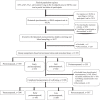The role of physical activity in the link between menopausal status and mental well-being
- PMID: 32049927
- PMCID: PMC7147406
- DOI: 10.1097/GME.0000000000001490
The role of physical activity in the link between menopausal status and mental well-being
Abstract
Objective: To examine the relationship between menopausal status and mental well-being, and whether this relationship varies as a function of physical activity (PA).
Methods: Based on a hormonal analysis and bleeding diary, women aged 47 to 55 were categorized as pre (n = 304), early peri (n = 198), late peri (n = 209), or postmenopausal (n = 387). Mental well-being was assessed using the Centre for Epidemiologic Studies Depression Scale, the International Positive and Negative Affect Schedule Short Form, and the Satisfaction with Life Scale. PA was self-reported and categorized as low, medium, and high. Associations between variables were analyzed using multivariate linear regression adjusted for age, marital and employment status, parity, self-reported mental disorder, use of psycholeptics and psychoanaleptics, and menopausal symptoms.
Results: Depressive symptoms were lower amongst the pre than postmenopausal women (B = 0.07, confidence interval 0.01-0.13). Menopausal symptoms attenuated these associations. Menopausal status showed no associations with life satisfaction, or with positive or negative affectivity.Women with high PA scored higher on positive affectivity, and the pre, early peri, and postmenopausal women scored higher on life satisfaction (B = 0.79, P < 0.001; B = 0.63, P = 0.009; B = 0.42, P = 0.009, respectively) and scored lower on depressive symptoms (B = -0.13, P = 0.039; B = -0.18, P = 0.034; and B = -0.20, P < 0.001, respectively) than their low PA counterparts. The pre and postmenopausal women with medium PA scored higher on life satisfaction (B = 0.54, P = 0.001; B = 0.038, P = 0.004, respectively) than those with low PA.
Conclusions: Postmenopausal women reported marginally higher depressive symptoms scores compared with premenopausal women, but menopause was not associated with positive mental well-being. However, this association varies with the level of PA. : Video Summary:http://links.lww.com/MENO/A520.
Comment in
-
The associations between menopausal symptoms and mental well-being: the role of types of physical activity.Menopause. 2020 Apr;27(4):380-381. doi: 10.1097/GME.0000000000001543. Menopause. 2020. PMID: 32187133 No abstract available.
Similar articles
-
Menopausal symptoms appear before the menopause and persist 5 years beyond: a detailed analysis of a multinational study.Climacteric. 2012 Dec;15(6):542-51. doi: 10.3109/13697137.2012.658462. Epub 2012 Apr 24. Climacteric. 2012. PMID: 22530706
-
Associations of physical performance and physical activity with mental well-being in middle-aged women.BMC Public Health. 2021 Jul 23;21(1):1448. doi: 10.1186/s12889-021-11485-2. BMC Public Health. 2021. PMID: 34301225 Free PMC article.
-
The associations between menopausal syndrome and depression during pre-, peri-, and postmenopausal period among Taiwanese female aborigines.Psychiatry Clin Neurosci. 2009 Oct;63(5):678-84. doi: 10.1111/j.1440-1819.2009.02001.x. Epub 2009 Jun 30. Psychiatry Clin Neurosci. 2009. PMID: 19570147
-
Depression during the perimenopause: A meta-analysis.J Affect Disord. 2016 Dec;206:174-180. doi: 10.1016/j.jad.2016.07.040. Epub 2016 Jul 22. J Affect Disord. 2016. PMID: 27475888 Review.
-
Management of depressive symptoms in peri- and postmenopausal women: EMAS position statement.Maturitas. 2020 Jan;131:91-101. doi: 10.1016/j.maturitas.2019.11.002. Epub 2019 Nov 5. Maturitas. 2020. PMID: 31740049 Review.
Cited by
-
Physical activity, anthropometric measurements, quality of life and menopausal symptoms among South-Indian women.Prz Menopauzalny. 2023 Dec;22(4):191-195. doi: 10.5114/pm.2023.133867. Epub 2023 Dec 21. Prz Menopauzalny. 2023. PMID: 38239405 Free PMC article.
-
Association between Physical Activity, Body Composition, and Metabolic Disorders in Middle-Aged Women of Ksar el Kebir (Morocco).Int J Environ Res Public Health. 2023 Jan 18;20(3):1739. doi: 10.3390/ijerph20031739. Int J Environ Res Public Health. 2023. PMID: 36767104 Free PMC article.
-
Assessing the Acceptability and Effectiveness of Mobile-Based Physical Activity Interventions for Midlife Women During Menopause: Systematic Review of the Literature.JMIR Mhealth Uhealth. 2022 Dec 9;10(12):e40271. doi: 10.2196/40271. JMIR Mhealth Uhealth. 2022. PMID: 36485026 Free PMC article.
-
Effectiveness of lifestyle related interventions to improve quality of life among postmenopausal women in selected slums of Bhubaneswar: A community based quasi experimental study.J Educ Health Promot. 2023 Nov 27;12:388. doi: 10.4103/jehp.jehp_599_23. eCollection 2023. J Educ Health Promot. 2023. PMID: 38333177 Free PMC article.
-
Effects of physical activity on menopausal symptoms, psychosomatic factors and well-being among working women in England: A path analysis.Womens Health (Lond). 2024 Jan-Dec;20:17455057241290370. doi: 10.1177/17455057241290370. Womens Health (Lond). 2024. PMID: 39508619 Free PMC article.
References
-
- Rannevik G, Jeppsson S, Johnell O, Bjerre B, Laurell-Borulf Y, Svanberg L. “Reprint of” A longitudinal study of the perimenopausal transition: altered profiles of steroid and pituitary hormones, SHBG and bone mineral density. Maturitas 2008; 61:67–77. - PubMed
-
- Friedman HS, Kern ML. Personality, well-being, and health. Annu Rev Psychol 2014; 65:719–742. - PubMed
-
- Steptoe A, Wardle J. Enjoying Life and Living Longer. Arch Intern Med 2012; 172:273–275. - PubMed
MeSH terms
LinkOut - more resources
Full Text Sources
Medical


